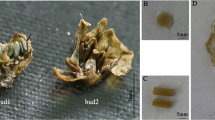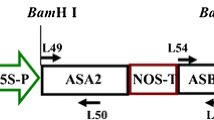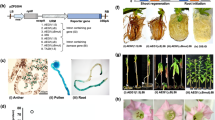Abstract
Targeted gene expression in plants allows us to further study biological traits of interest, such as reproductive and developmental processes. Here, the tobacco TA29 anther-specific promoter was used to direct the expression of the ricin enzymatic subunit A (RTA) in transgenic tobacco plants, phenotypic analysis of the resulting positive transgenic tobacco (Nicotiana tabacum L.) plants demonstrated that RTA expression led to a reduction in pistil length and shriveling of anthers, as well as the grayish-brown color of anthers, the reduced pollen viability and male sterility. For the first time, a plant-derived ricin gene enzymatic subunit A (RTA) expression system under the tissue-specific promoter was demonstrated to be sensitive and efficient in controlling plant sterility and creating male-sterile materials. Consequently, it could be used to control other agronomic traits and produce hybrid seeds in plants in the future.
Similar content being viewed by others
Avoid common mistakes on your manuscript.
Introduction
The use of tissue-specific promoters to control the expression of toxin genes is effective in regulating fertility and resistance, as well as in evaluating the immunoprotective capabilities, of plants [1,2,3], In Table 1, we provide a list of the representative literature and relevant information on toxin genes and specific promoters used in plants. Toxin genes that are widely used in plants include diphtheria toxin A chain (DTA) [4] and Barnase [5], both of which are derived from bacteria. In addition to the listed toxin genes, many others, including those encoding ricin, microtoxin and marine biotoxin, have not been used in this kind of research. Ricin is a toxic substance extracted from the seeds of the perennial castor bean plant. Ricin has a ricin protein, ricinine, ricin allergen and hemagglutinin [6], and one ricin molecule is bound by subunits A and B through disulfide bonds. The enzymatic subunit A chain (RTA) is the active toxin chain, while the subunit B chain plays a decisive role in the hemagglutination activity [7]. The toxic effects of ricin on plant pests have been confirmed and studied [8]; however, plant-derived ricin has not been proven to have a toxic effect on plant cells [9]. Here, the toxin gene RTA from ricin, driven by an anther-specific promoter TA29, was expressed [10] in tobacco (Nicotiana tabacum L.). The corresponding transgenic plants showed male sterility, which provides an application prospect for ricin in controlling other agronomic traits and plant phenotypes in the future.
Materials and Methods
Plant Materials and DNA Extraction
Nicotiana tabacum L. cv. ‘Honghuadajinyuan’ was grown in the greenhouse in Qingdao city. Total DNA from leaves was extracted using a Plant DNA Isolation Reagent (TaKaRa, Japan). Samples were electrophoresed on 1% agarose gels, and their purity levels were checked using a NanoDrop2000 spectrophotometer (Thermo, USA).
RNA Extraction and RT-PCR
Total RNA from each sample (roots, stems, leaves anthers, pistils and petals) was extracted using the GeneJET™ Plant RNA Purification Mini Kit (MBI Fermentas, Canada). Samples were run on 1% agarose gels, and the purity was checked using a NanoDrop2000 spectrophotometer. Total RNA was reverse transcribed using the RevertAid™ First-Strand cDNA Synthesis Kit (MBI Fermentas, Canada), and cDNA was used for RT-PCR analyses with primers specific to the TA29 genes (TA29-RF/ TA29-RR) (Table 2).
Amplification of the Tobacco TA29 Promoter
The promoter region of TA29 was amplified from tobacco cv. ‘Honghuadajinyuan’ genomic DNA by PCR using the specific primers PNtTA29-F and PNtTA29-R (Table 2).
Construction of PNtTA29::RTA Recombinant Vector and Genetic Transformation
The 1489-bp promoter was amplified by PCR and inserted in-frame in front of the GUS reporter gene using the restriction enzyme restriction sites HindIII and BamHI in the PBI121 vector [23] (provided by our laboratory) (Fig. 1). The CDS sequence of the Ricinus communis ricin gene RTA [24] (GenBank: X52908.1) was synthesized by BGI and inserted into the PNtTA29::GUS vector using restriction enzymes BamHI and SacI. This construct, named PNtTA29::RTA, was then transformed into Agrobacterium tumefaciens strain EHA105 and introduced into cultivated tobacco ‘Honghuadajinyuan’ plants using the leaf disc method [25]. Transgenic plants were selected on MS culture medium [26] containing 0.1 mg/ml kanamycin.
Pollen Viability Experiment and Microscopic Observations of the Anthers
Positive transgenic plants were selected by PCR using the specific primers TA29-F and RTA-R (Table 2). The floral organs of transgenic T0 plants were observed and photographed. Anthers were isolated from flowers and observed under a Leica S8AP0 microscope (Leica, Germany). Iodine and potassium iodide were prepared by dissolving 80 g potassium iodide and 10 g iodine in 100 ml distilled water [27]. After staining with the iodine and potassium solution for 5 min, pollen was viewed using a Nikon Eclipse 80i fluorescence microscope (Nikon, Japan).
Results
Tissue Expression Pattern of TA29 in Tobacco
RT-PCR was conducted in anther, pistil, petal, leaf, stem and root of cultivated tobacco to verify the expression specificity of TA29. The product length is 758 bp according to the primer TA29-RF/TA29-RR, the examination result showed that TA29 can express specifically in anthers (Fig. 1), therefore it can be used for the following construction of recombinant vector.
Construction of the PNtTA29::RTA Recombinant Vector
The recombinant vector containing RTA driven by the anther-specific promoter TA29 was constructed. A 1489-bp TA29 promoter region (PNtTA29) was isolated from tobacco variety ‘Honghuadajinyuan’. A recombinant vector that contains ricin (RTA) driven by PNtTA29 was constructed based on the PNtTA29::GUS recombinant vector (Fig. 2). A PCR examination of eight putative transgenic plants was conducted (Fig. 3).
Effects of RTA on the Creation of Male-Sterile Tobacco
In total, eight positive transgenic T0 plants and four cultivated tobacco plants of variety ‘Honghuadajinyuan’ were regenerated and grown to maturity in the greenhouse. No significant phenotypic differences were noted between T0 and control plants before flowering. The floral organs of the PNtTA29::RTA transgenic tobacco plants were observed and compared with those of untransformed plants. A reduction in pistil length and the shriveling of anthers were clearly observed in transgenic plants (Fig. 4a–d). In addition, the anthers of transgenic plants were grayish-brown compared with red-brown of control plants (Fig. 5c–d), the detection of pollen viability includes pollen staining, pollen germination in vitro and pollen pollination and fruiting detection [28], among which iodine-potassium iodide staining is a kind of simple and rapid method, according to the characteristic of starch turning blue with iodine, the content of starch in pollen grains and then the activity level of pollen was determined according to the depth of blue [29]. From the observation under the microscope the living pollens become reddish-brown because of the deep staining, while the non-living pollens are grayish-brown and have an irregular shape. The proportion of active pollens in five fields was randomly counted and the percentage of pollen viability was calculated, after staining, 95% of the control pollens were reddish-brown, and only 2% of the transgenic pollens were active. The results indicate the unusual phenotype of transgenic T0 flowers. Pollen viability experiments further demonstrated that not only was less pollen released from anthers of transformants but the pollen viability was also greatly reduced (Fig. 5a–d). Compared with the control plants, the transgenic tobacco can flower normally, but can not produce seeds and show sterility (Fig. 6a–b). The stability of its fertility remains to be further observed.
Discussion
Male sterility is an important method to produce hybrid seeds, and currently male-sterile materials can be artificially created by genetic engineering, including utilizing the expression of toxin genes driven by anther development-associated promoters, which is an effective method. Some of the available toxin genes that have been successfully studied are from bacteria, such as DTA and Barnase, and some are from animals, such as RIP and Pseudomonas aeruginosa exotoxin A. However, there is rare report on utilizing the toxin genes from plants to obtain male-sterile materials. Here, an RTA gene from castor bean plants was exploited to obtain male-sterile materials for the first time. Ricin is isolated from the seeds of castor beans and toxic to all mammalian cells. It is usually used to kill tumor cells in medicine and to develop biological insecticides in botany. The ability of the RTA gene to induce male sterility represents a new strategy for the production of hybrid crop plants and the optimization of other agronomic traits, including branching and stress resistance.
References
Wang, Q., et al. (2016). Transgenic Bt cotton driven by the green tissue-specific promoter shows strong toxicity to lepidopteran pests and lower Bt toxin accumulation in seeds. Science China Life Sciences,59(2), 172–182.
Shah, A. D., et al. (2011). Spider toxin (Hvt) gene cloned under phloem specific RSs1 and RolC promoters provides resistance against American bollworm (Heliothis armigera). Biotechnology Letters,33(7), 1457–1463.
Tiwari, S., et al. (2009). High level expression of a functionally active cholera toxin B: Rabies glycoprotein fusion protein in tobacco seeds. Plant Cell Reports,28(12), 1827–1836.
Twell, D. (1995). Diphtheria toxin-mediated cell ablation in developing pollen: Vegetative cell ablation blocks generative cell migration. Protoplasma,187(1–4), 144–154.
Hartley, R. W. (1989). Barnase and barstar: Two small proteins to fold and fit together. Trends in Biochemical Sciences,14(11), 450–454.
Olsnes, S., & Kozlov, J. V. (2001). Ricin. Toxicon,39(11), 1723–1728.
Roberts, L. M., et al. (1985). The primary sequence of Ricinus communis agglutinin: Comparison with ricin. Journal of Biological Chemistry,260(29), 15682–15686.
Dias, R., et al. (2015). Insights into animal and plant lectins with antimicrobial activities. Molecules,20(1), 519–541.
Lord, J. M., Roberts, L. M., & Robertus, J. D. (1994). Ricin: Structure, mode of action, and some current applications. The FASEB Journal,8(2), 201–208.
Koltunow, A. M., et al. (1990). Different temporal and spatial gene expression patterns occur during anther development. The Plant Cell,2(12), 1201–1224.
Chen, G., et al. (2012). Developing transgenic plants with no seeds by transforming Barnase gene. Journal of Agricultural Biotechnology,20(2), 113–120.
Guerineau, F., et al. (2003). Temperature sensitive diphtheria toxin confers conditional male-sterility in Arabidopsis thaliana. Plant Biotechnology Journal,1(1), 33–42.
Mariani, C., et al. (1990). Induction of male sterility in plants by a chimaeric ribonuclease gene. Nature,347(6295), 737.
Thorsness, M. K., et al. (1993). Genetic ablation of floral cells in Arabidopsis. The Plant Cell,5(3), 253–261.
Czakó, M., et al. (1992). Differential manifestation of seed mortality induced by seed-specific expression of the gene for diphtheria toxin A chain in Arabidopsis and tobacco. Molecular and General Genetics MGG,235(1), 33–40.
Czako, M., & An, G. (1991). Expression of DNA coding for diphtheria toxin chain A is toxic to plant cells. Plant Physiology,95(3), 687–692.
Cho, H.-J., et al. (2001). Production of transgenic male sterile tobacco plants with the cDNA encoding a ribosome inactivating protein in Dianthus sinensis L. Molecules & Cells,11(3), 326–333.
Koning, A., et al. (1992). Arrest of embryo development in Brassica napus mediated by modified Pseudomonas aeruginosa exotoxin A. Plant Molecular Biology,18(2), 247–258.
Goldman, M., Goldberg, R., & Mariani, C. (1994). Female sterile tobacco plants are produced by stigma-specific cell ablation. The EMBO Journal,13(13), 2976–2984.
Kim, Y., & An, G. (1992). Pollen-specific expression of the Arabidopsis thaliana α 1-tubulin promoter assayed by β-glucuronidase, chloramphenicol acetyltransferase and diphtheria toxin reporter genespromoter assayed by β-glucuronidase, chloramphenicol acetyltransferase and diphtheria toxin reporter genes. Transgenic Research,1(4), 188–194.
Lee, Y.-H., et al. (2003). Induction of male sterile cabbage using a tapetum-specific promoter from Brassica campestris L. ssp. pekinensis. Plant Cell Reports,22(4), 268–273.
Kim, H. U., et al. (1998). Pollen ablation of transgenic tobacco plants by expression of the diphtheria toxin A-chain gene under the control of a putative pectin esterase promoter from Chinese cabbage. Molecules & Cells,8(3), 310–311.
Chen, P.-Y., et al. (2003). Complete sequence of the binary vector pBI121 and its application in cloning T-DNA insertion from transgenic plants. Molecular Breeding,11(4), 287–293.
Tregear, J. W., & Roberts, L. M. (1992). The lectin gene family of Ricinus communis: Cloning of a functional ricin gene and three lectin pseudogenes. Plant Molecular Biology,18(3), 515–525.
Bechtold, N., & Bouchez, D. (1995). In planta Agrobacterium-mediated transformation of adult Arabidopsis thaliana plants by vacuum infiltration. In Gene transfer to plants (pp. 19–23). New York: Springer.
Gamborg, O., et al. (1976). Plant tissue culture media. In Vitro,12(7), 473–478.
Kearns, C. A., & Inouye, D. W. (1993). Techniques for pollination biologists. Boulder, CO: University Press of Colorado.
Shivanna, K., Linskens, H., & Cresti, M. (1991). Pollen viability and pollen vigor. Theoretical and Applied Genetics,81(1), 38–42.
Heslop-Harrison, J., & Heslop-Harrison, Y. (1970). Evaluation of pollen viability by enzymatically induced fluorescence; intracellular hydrolysis of fluorescein diacetate. Stain Technology,45(3), 115–120.
Funding
The Agricultural Science and Technology Innovation Program (ASTIP-TRIC02). Science Foundation for Young Scholars of Tobacco Research Institute of Chinese Academy of Agricultural Sciences (2019B05).
Author information
Authors and Affiliations
Corresponding author
Additional information
Publisher's Note
Springer Nature remains neutral with regard to jurisdictional claims in published maps and institutional affiliations.
Rights and permissions
About this article
Cite this article
Lv, J., Dai, Cb. & Sun, Yh. Induction of Male Sterility in Tobacco by Anther-Specific Expression of the Gene for Ricin Enzymatic Subunit A Chain RTA. Mol Biotechnol 62, 364–369 (2020). https://doi.org/10.1007/s12033-020-00252-0
Published:
Issue Date:
DOI: https://doi.org/10.1007/s12033-020-00252-0










